Ready to learn Big Data? Browse Big Data Training and Certification Courses developed by industry thought leaders and Experfy in Harvard Innovation Lab.
How Artificial Intelligence and Machine Learning can be leveraged to boost efficiency and customer engagement in Retail
Fashion is a glamorous business. And an increasingly controversial one.
British fashion house Burberry recently sparked a massive outcry after burning £28 million of excess stock (as listed in its annual report), continuing a “brand protection” practice associated with other fashion labels like Louis Vuitton and Chanel.
Far from protecting Burberry’s brand, this backlash could not have come at a worse time for the label. The industry is already under intense scrutiny for years of unethical practices. In addition, fashion houses have to contend with changing tastes and shopping habits. Millennials in particular are increasingly buying their clothes online instead of shopping at swanky stores, and expect fast delivery and discounts. They are also reshaping their attitudes towards fashion, as seen in the increasing popularity of sustainable fashion and vintage pieces, and the rise of streetwear labels that made a name for themselves in the e-commerce space. Even investors were outraged by Burberry’s annual report, with many questioning why there was so much unsold merchandise to begin with and why no attempts were made to sell the leftover pieces.
The challenges faced by fashion brands are symptomatic of the retail industry as a whole, which has increasingly had to contend with a paradigm shift in how its customers select and purchase consumer goods and services. Retailers are now being forced to move online, and take a long hard look at how they are using their physical stores.
Seeing the number of big retail chains that are closing stores (think Sears and Payless) may support a surface-level impression that retail is dying out. But that could not be further from the truth. The industry is booming in the digital space. The revolution started by companies like Amazon and eBay has led to huge challenges for the traditional retail business model, but also massive potential for retailers and consumers alike.
This also means that there is an increasing shift towards optimization and efficiency, and a shift away from excess and waste. Retail is well-placed to benefit from the intersection of Artificial Intelligence, machine learning and big data. There is a need to manage and track a large number of items across various categories, track consumers’ shopping habits and above all, maintain a compelling brand that keeps consumers coming back. Today’s consumer wants to keep up with the latest trends, but also craves convenience; hence, the popularity of subscription boxes and online shopping. A recent survey of retailers worldwide identified cost savings, enhanced decision-making and process automation as some of the main areas that AI has the potential to impact meaningfully.
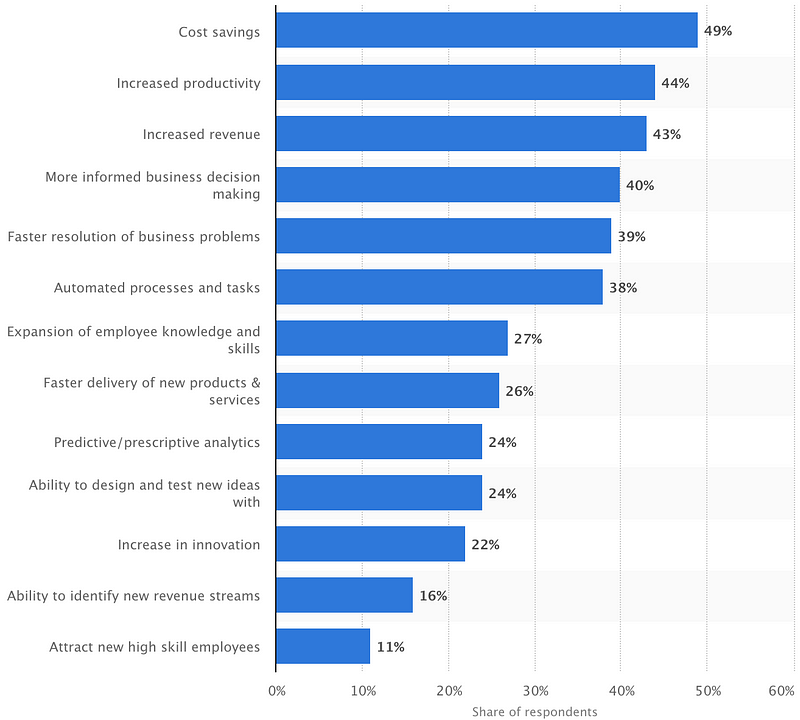
Benefits of AI for Retail (Survey). Statista (2018).
Of course, generating tangible insights from data collected across multiple channels requires the use of algorithms and models that can process and learn from huge datasets, and make actionable predictions and recommendations. Using data science techniques like Discriminant Analysis, the k-Nearest Neighbors algorithm, Deep Learning and Support Vector Machines, there is incredible potential for improving classification, optimization and forecasting within the retail and CPG spaces, while taking advantage of AI functionalities like Computer Vision and Natural Language Processing . Here is a look at 5 applications of machine learning and AI in retail, with examples of retailers who have already benefited from them.
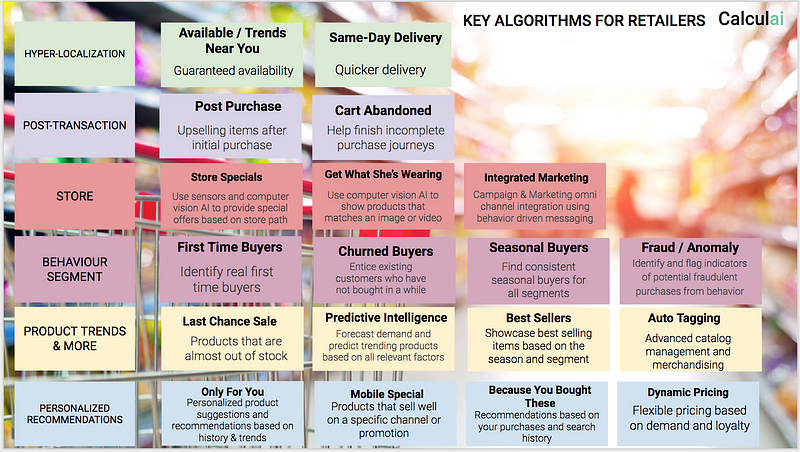
CalculAI has identified a range of key algorithms for digital retailers (especially those with a physical presence) to effectively use AI and machine learning. This image lists a subset of them.
1. Personalization of Recommended Products
Recommendation engines do not just bring consumers’ attention to items they are unlikely to discover on their own. When they are rightly done, they keep consumers coming back for more, and also help the retailer forecast demand and make supply decisions well in advance.
Amazon has one of the best recommendation engines on the market today, with 55% of its sales driven by its recommendations. Its recommendation algorithms take into account not just your own behaviour (what items they have clicked on, how often they place orders, what they have searched for), but also the purchasing behavior of other consumers who are similar to you. For example, if you are searching for Mother’s Day gifts, Amazon’s recommendations engine will look at your own purchasing behaviour, and the behavior of other people who are also searching for similar gifts. All of this is made possible by item-to-item collaborative filtering, which was developed by Amazon itself to solve the problem of existing algorithms being unable to scale to the massive volume its platform deals with. This method focuses on the rating distribution per item, (as opposed to per user). This allows for more stable rating distributions, which equates to the ability to scale to huge datasets.
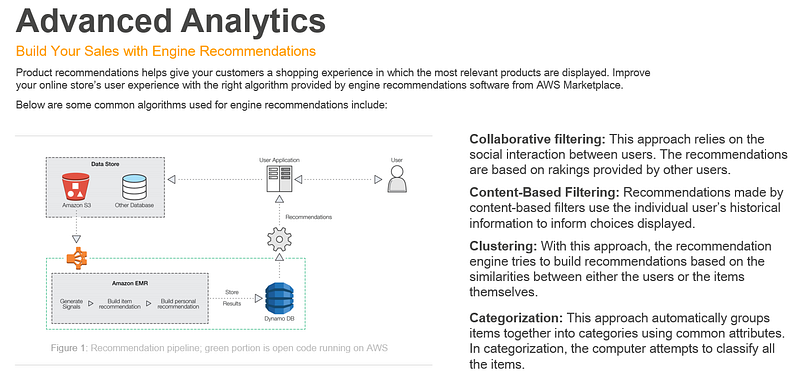
Amazon Web Services now offer product recommendation engines based on methods that have worked for Amazon.
Such algorithms ensure significant upsell, in which the seller induces the consumer to buy more expensive or additional items to secure a more profitable sale. They also take the guesswork of a human sales assistant out of the equation, allowing for highly customized recommendations that are extremely likely to appeal to the customer. This also allows retailers to anticipate what consumers are going to buy in the future, once again taking the guesswork out of maintaining sufficient stock.
2. Supply Chain Planning
Traditionally, inventory planning has involved a significant amount of trial and error, because there are so many factors that are inherently uncertainty. How many people will shop next month? Will there be any unexpected situations that alter purchasing behaviour. Will a popular item suddenly fall out of favor, or vice versa? But with machine learning, several parameters can be studied to make informed decisions backed by extensive data analysis.
Root cause analysis, which helps to identify the reason for faults within an existing system, is one the main areas that can be gainfully automated. Machine learning algorithms can tell a more complete story of exactly what went wrong, identifying anomalies such as incomplete data or lapses in communication, and pinpoint exactly where each of these failures happened along the supply chain. Human bias and guesswork is eliminated in identifying the root cause, and this is applicable for any stage, be it warehouse processing or vendor management.
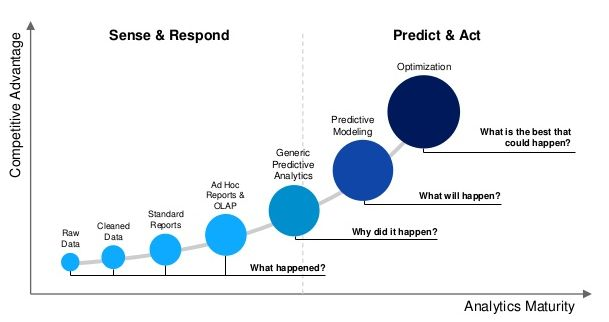
Automating the root cause analysis process quickly identifies pain points and allows for timely and effective action.
Similar algorithms can help with demand planning, by identifying top performing items that drive the most sales across multiple channels, so that best practices can be quickly identified and scaled. With the use of SKUs, there is already a significant amount of data available to retailers. The key is being able to process and analyze that data in useful ways. The sophistication afforded by machine learning algorithms allows for more segmentation, which allows for more detailed and descriptive insights. The performance of a single item can be tracked across multiple categories, and multiple parameters can be included in the analysis. Discriminant analysis can also be incorporated into machine learning algorithms addressing this area to enable and improve segmentation and classification.
The old paradigm of demand forecasting treats every SKU & transaction as an isolated event, and relies on historical data and manual decision-making (for example, how similar two items are). This often ignores factors like promotional cadence, market cannibalization and seasonal changes, which are too complex for traditional forecasting tool-sets.
Using machine learning allows retailers to combine historical and real-time data, and identify patterns that humans and traditional forecasting tools would have missed. In addition, AI can automate the process of filling out databases, particularly fixed-data fields, using Natural Language Processingand Computer Vision to learn from product descriptions and images.

Computer Vision can help to quickly process visual information about inventory and output the relevant data about attributes and quantity into databases for further analysis.
Deep learning can then be used to provide more nuanced insights into each product. In this way, algorithms can take over the process of comparing items against each other and tracking their performance in various situations, even making suggestions to support key business decisions. This significantly cuts costs by reducing errors in inventory management and avoiding situations of excess or insufficient stock. The resulting boost in efficiency is accompanied by an increase in gross margins and top-line growth.
“AI technologies could eliminate many levels of manual activities in areas such as promotions, assortments, and supply chain. AI will enable retailers to increase both the number of customers and the average amount they spend by creating personal and convenient shopping experiences.” — McKinsey Global Institute (2017)
3. Optimized Route Planning
Location intelligence is already reshaping how retailers plan delivery routes. Route planning is another key area that stands to benefit from data analytics due to the necessity of collecting real-time data and making adjustments and decisions based on current conditions. Optimizing a delivery route involves making a calculated decision for each turn and each stop based on several variables, including traffic, weather conditions and the location of each customer. Connected logistics is the way forward here, leveraging the Internet of Things to enable the collection of enough data to feed to machine learning algorithms. Trackers and sensors can collect information about weather, temperature and other relevant factors, telling a complete story of the circumstances in which the delivery is being made. Machine learning models can process this data and derive routes that optimize costs and time better than humans and current navigation software, signifying the next step forward in the booming telematics market.
For an example of a company that introduced elements of machine learning into its route optimization, and saw productivity and efficiency gains almost immediately, we turn to Anheuser-Busch. The brewing giant ran a pilot in two cities by using a machine learning platform for day-of routing. A review of metrics like driver satisfaction and working hours just a few months later resulted in Anheuser-Busch expanding their use of the platform to all of their American wholesalers and some of their Canadian wholesalers as well. The platform they used also takes into account the collective experience of experienced drivers (regarding details such as parking and the best times for delivery to a particular customer) and incorporates these variables to suggest the best time to make a delivery for each client. This combination of dynamic routing and constant performance optimization bodes well for retailers seeking to optimize efficiency and customer service.
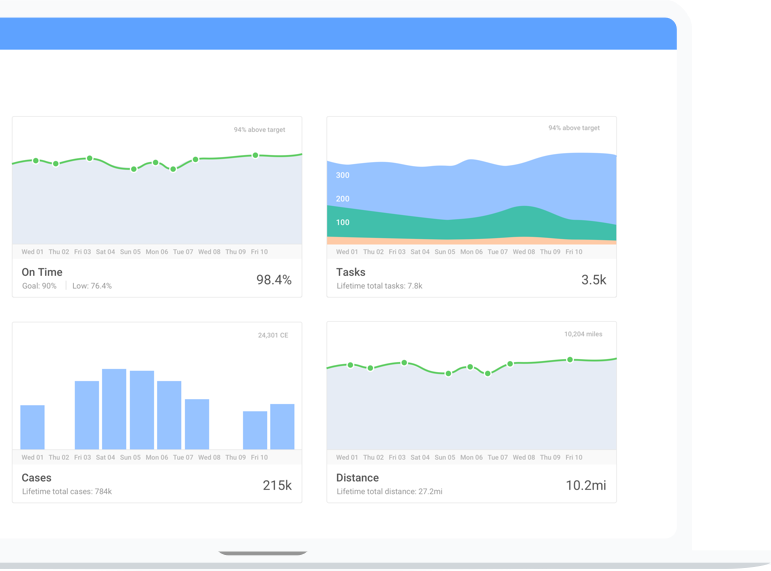
Machine learning-driven platforms, such as the one used by Anheuser-Busch, track metrics to allow retailers and algorithms to constantly learn from prior data and improve performance.
Using machine learning in route planning can also help to reduce the last mile problem in retail, which has only become more relevant with the growth of e-commerce. The final leg of the delivery process, when the package is transported central depot to the consumer’s house, is often fraught with problems and lapses in communication. Location intelligence can help to automate the route-planning and delivery process, as Alibaba and Amazon have already done with the use of drones, and increase reliability and efficiency. In addition, each optimized pathway used in a delivery run is stored as historical data for machine learning algorithms to learn from. Enterprise software providers have already recognized the need for tools to support location intelligence and route planning, such as Microsoft, which has developed enterprise machine learning tools specifically for CPG companies looking to transform how they plan deliveries. With the deeper analytics and improved integration afforded by machine learning, retailers are already looking into ways to scale same-day deliveries.
4. Shopping Assistants
We are used to asking human sales assistants for help, but they themselves are often unsure of where a particular product is or how much stock is left. Machine learning can help to effectively integrate all the product tracking information available to retailers while providing customers with a personalized shopping experience. Cognitive customer assistant tools need to receive input in natural language and output answers, directions and instructions in natural language as well. Such platforms allow customers to ask questions catered to their own preferences, and get answers which they can comfortably understand. Building on the existing developments in chatbot technology, much of the research and development in this area has been influenced by the belief that customers increasingly prefer the help of their smartphones as opposed to sales assistants when they are in a physical retail location.
Macy’s has already taken a serious step in this direction, partnering with IBM’s Watson to launch a shopping assistant platform called Macy’s On Call. The mobile-based platform is powered by AI, and uses Watson’s Natural Language Classifier API. It even has bilingual support for Spanish-speaking customers, underscoring the importance of personalized services for customers.
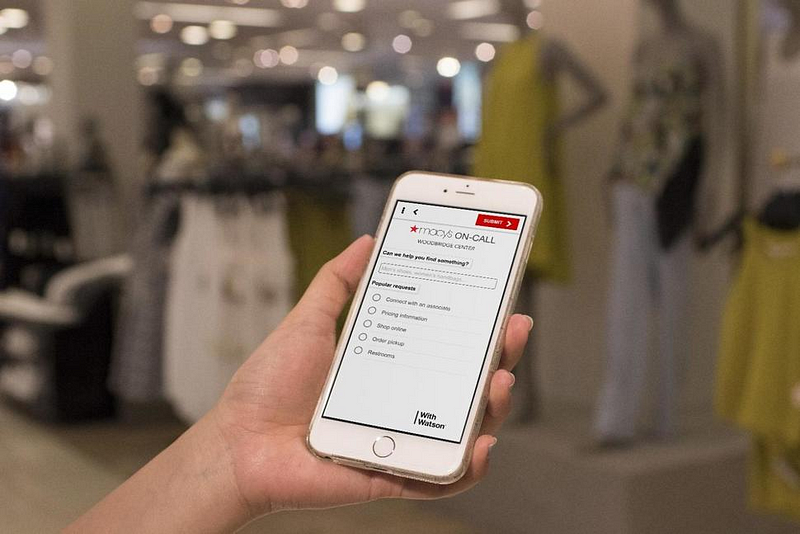
Macy’s On Call aims to provide seamless human-software interaction on a mobile platform.
For such platforms to be effective and efficient, the underlying machine learning algorithms need to efficiently process data about the relevant products within the store, using techniques like neural networks and deep learning. This allows for the platform to draw conclusions about concerns like when an item will be in stock or suggest similar items to a particular item if the customer wants to look through more options. As with other machine learning applications, digital shopping assistants gradually become more intelligent as they are used by more customers with greater frequency.
Shopping assistants are only one part of the larger push towards meaningfully integrating mobile technology into the retail environment. Doing so requires an understanding of the key touch points where consumers interact with the retailer. While physical retailers are well-versed with stocking products on shelves and serving customers at the checkout counter, they are limited in their ability to engage with consumers during the planning stage and post-purchase, when customers are using the products they bought at home. Mobile technology has the potential to change that and provide new avenues for retailers to holistically meet customers’ needs.
5. Price Optimization & Promotions
Price optimization is another area in which the number of parameters quickly overwhelms the human mind and even current software tools. Machine learning algorithms are able to create multiple decision trees based on a variety of sub-groups, before combining everything into a comprehensive predictive model that outputs sophisticated analysis and insights. After being sufficiently trained, the model can be trusted to make accurate predictions. This can be particularly useful for retailers seeking to study the potential impact of sales promotions.
For a comprehensive look into the impact of a potential promotion, there are several variables that need to be taken into account, such as the amount of the discount, the type of product, price elasticity and competition from other retailers and promotions. There are also other factors like shelf placement and marketing techniques that are difficult to input into traditional price optimization software or spreadsheets. Using a combination of AI to collect the relevant information and machine learning to process that data has already been proven to yield more accurate predictions than traditional methods. A significant amount of risk is removed from promotions, allowing retailers to only implement promotions that are very likely to deliver a satisfactory ROI. There is also no need to try out potentially risky promotions, as the algorithm already simulates the potential outcomes of each promotion, and recommends the promotions that are extremely likely to boost sales and profits.
The use of real-time data also enables the implementation of a truly agile pricing framework, while the automation afforded by AI ensures errorless data collection. Dynamic pricing is the way forward for digital platforms that expect to deal with significant volume. For example, Airbnb recommends prices to potential hosts, taking into account multiple variables that have different weightings applied to them. The assumptions behind the original algorithm were tested against prior transaction data to model against actual outcomes. The classifier technique is used by the algorithm to calculate the likelihood of a property being booked based on the property’s attributes and real-time market data. Today, Airbnb’s machine learning algorithm categorizes properties based on factors like the photos used in the listing, and even adjusts prices on its own based on changes in neighborhood boundaries. Airbnb has now launched an open-source machine learning package called Aerosolve that includes geo-based features and emphasizes user interaction.
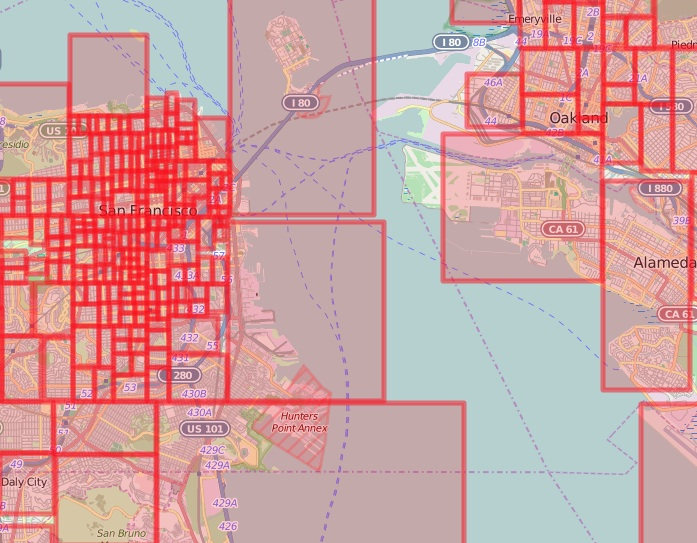
Airbnb’s Aerosolve generates neighborhood polygons based on listing density, using a multi-scale k-d tree, and suggests pricing tips.
Inventory management and demand planning are also made easier, as machine learning enables retailers to make more informed decisions when ordering stock. As machine learning becomes more prevalent in price optimization, the next step would be to customize promotions by offering personalized promotions to individual customers based on their prior shopping behaviour and a variety of other factors.
Conclusion
With the increasing use of machine learning and AI, retailers can boost efficiency and productivity while actively engaging with consumers via digital and mobile platforms. This is the step forward that retailers should be taking, while keeping in mind the need to reduce waste and significantly improve efficiency. There is a real need for automation and deeper data analysis to identify patterns that support cost-effective and accurate decisions. Retailers have to figure out now how to meaningfully connect with consumers who expect intuitive and convenient shopping experiences. Ultimately, retailers need to focus on bringing customers back by providing them with a complete shopping experience.
Find out more about our work in intelligent process automation, and get in touch at prannoiy@calcul.ai.



